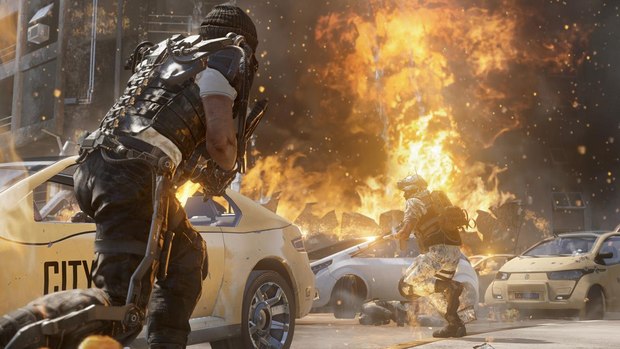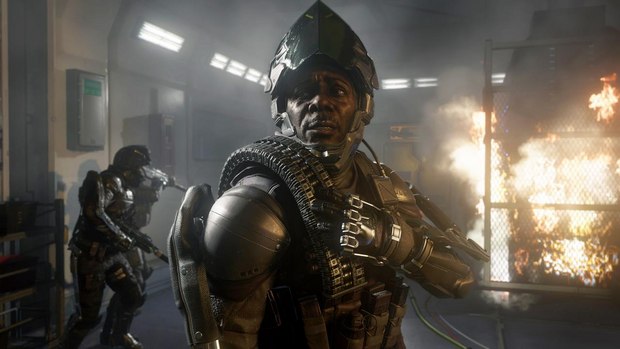Hungarian studio creates 28 minutes of game cinematics for Activision’s 14th title in the top-rated series, ‘Call of Duty: Advanced Warfare.’
BUDAPEST, HUNGARY -- The Call of Duty series is synonymous with explosive blockbuster entertainment, but the 14th series entry, Call of Duty: Advanced Warfare, spins its narrative around the human element of war, and that required groundbreaking facial animation to achieve the necessary emotional impact. It was up to Digic Pictures, along with a little help from Faceware Technologies to deliver.
2014’s Call of Duty: Advanced Warfare follows a death-defying escape from an enemy compound, characters Mitchell, Gideon and Ilona stand over the body of the badly wounded Cormack in the back of a flatbed truck, life ebbing from his body. There are no extravagant theatrics here. The drama comes instead through the subtle flickers of emotion that cross over each of the soldiers’ faces, the muted expressions of stern grief and grim determination. In a medium where death is often an unremarkable occurrence, here the passing of one character is filled with weight and gravitas.
This moment of somber reflection, along with the other 28 minutes of Advanced Warfare cinematics, were created by the extremely talented Hungarian studio Digic Pictures. With experience in video game animation that extends across such titles as Assassin’s Creed and Halo, Digic has built up a strong understanding of what makes for a good cut scene, namely, believability.
“This project marked the first time we had worked on a Call of Duty title, and it was the first time we had worked with publisher Activision and developer Sledgehammer Games,” says the team at Digic Pictures. “That’s a lot of big firsts, so we definitely wanted to prove ourselves, especially on the facial animation front. By far the most important aspect of our brief was that the client wanted believable, emotive performances to really shine through, to help gamers engage more deeply with the story and the characters than ever before on a Call of Duty title.”
On the basis of that one scene alone, Digic Pictures achieved those goals, creating a Call of Duty that resonates beyond the explosions. In order to create facial animation that expressed such nuanced emotion, Digic Pictures turned to the solutions provided by Faceware Technologies.
“For Advanced Warfare, the client really wanted to make sure that the players engaged with the characters on a deeper level than ever before,” begins Digic. “The game has a great story that’s not only grand in terms of scope, but is also intimately personal. To convey this, we had to bring the players close to the characters, and the best way to do this is through truly emotive facial performances.”
After a period of extensive internal testing, Digic began using Faceware’s solutions in production in 2012. The studio has become deeply involved with the software, gaining a deep understanding of its intricacies and the potential it holds. As such, Digic was able to squeeze out every last drop of emotion captured from the onset performances.
“For Advanced Warfare, the actors not only lent their voices and physical performances, both face and body, to the game characters, but also their actual likenesses,” said Digic. This means that the protagonist Mitchell actually looks like actor Troy Baker, and the same goes for all of the other characters in the game. This meant, that the facial performance captured from the actors didn’t have to be reinterpreted for a different face, which, would have a vastly different bone structure and vastly different volumes of tissue.
“Having this direct 1to1 correspondence made a huge difference right from the start, as it meant we also had perfect reference material of the actual actors performing their lines, which made it very clear what we had to achieve in the game cinematics.”
Each of the game’s actors was fully scanned, with dozens of FACS (Facial Action Coding System) facial poses recorded. After a significant amount of processing and retopologizing, the process of modifying a model’s topology for animation, these FACS could be combined with Digic’s facerigs to form complex facial animations.
“That’s where Faceware came in, to help drive our face rigs,” said Digic. “The headmounted camera footage we received onset was processed using Faceware’s Analyzer, and then applied to our face rigs with Retargeter – Retargeter is 100 percent compatible with our custom face rig, and that means no compromise is required at all when we use Faceware products. It works perfectly, capturing every tic and nuance present on the actors face, and all that feeds into the emotional impact of the cut scenes witnessed on the screen.”
For the facial elements of Advanced Warfare’s cinematics, Digic created approximately 17 minutes of content, multiplied by the 34 characters appearing on screen at any one time, that made for 1 hour of high-quality content that required processing. Even for the most talented keyframe animator, the fidelity required of the facial performances were beyond the reach of human ability alone. Faceware’s solutions were required to help Digic overcome half the battle.
“Unlike our usual projects, for Advanced Warfare we organized our team into smaller specializing units to create a more efficient workflow: one unit processed the captured footage in Analyzer, another unit worked with Retargeter, while the rest of the team worked on keyframe animation,” continued the Digic team.
As ever, the analyzed onset footage got the Digic team some of the way, but it was up to the deft hands of a talented animator to bring the footage to the final quality witnessed in the finished cinematics. However, Faceware’s tools were powerful enough that the original analyzed footage was far enough along for the animators to push it even further than they would have otherwise, and that meant achieving an even higher level of final quality than would have been possible otherwise.
“After using Faceware after a quick retarget phase, the character would suddenly come alive, with the eyes and muscles moving in believable rhythm,” explained Digic. “Simply put, we could achieve basic timing and animation much more quickly and accurately than we would by hand, which left us more time for detailed fine tuning. Faceware had already made enough of an impact that we could just spend more time really focusing on delivering the details. In general, Faceware’s solutions reduced the first part of our animation workflow by 6080 per cent. Without this important first step, the facial animation wouldn’t be effective, no matter how much detail work went into it.”
In some cases, the Digic team also found Faceware’s results were good enough to be used as is. “There were certainly some shorter scenes didn’t even require that additional keyframe animation work, such as on background characters, or in certain dynamic action shots. In those cases, Retargeter did enough of the work on its own.”
Part of the reason for this high fidelity of facial capture was the custom development carried out by Digic on its facial capture solutions, completed in close collaboration with Faceware Technologies itself.
“Advanced Warfare presented a real challenge with hard deadlines, so we needed to squeeze as much of that initial information out of the recorded footage as we could,” remembers Digic. “In order to achieve this we had a discussion with the Faceware team about using their software in a different way. The result of this was that the team gave us an option for tracking new parts of the face.”
In the stock Faceware solution facial performance is tracked in three separate groups: the eyes, the brows and the mouth. Digic Pictures was looking for an approach that would capture even more of the actor’s performance, attaining the kind of precision and detail we see in the cinematics.
“Rather than just track the inner relative movements of the face and then retarget them onto given controls on the face rig, we also isolated two new parts: the jaw and the cheeks,” explained Digic. “It was Faceware who made it possible for us to bind these elements to our system, and that was integral to getting that really accurate animation in Advanced Warfare.
Adding the jaw and cheek markers helped to really bring out the subtlety required of the character’s performances, as it enabled the team to represent facial motions that otherwise would not have been trackable.
“Independent jaw tracking is a very important development, as it allows for handling mouth/lip movements separately from movements of the jaw,” continued the Digic team. “This is important, because it means that actions which happen at an offset from each other can be tracked accurately. An example of this would be when the jaws begin to open yet the mouth itself is momentarily still closed, due to the lips being stuck together for a brief moment. Or, in the case of an M or a B sound, when the jaws are not closed, yet the lips are pressed together.”
This solution has proved so successful that it has now been adopted by teams on various other projects, helping them to also attain a whole new realm of realism.
“The new solution worked really well, and that’s all due to the fact that Faceware was so responsive and helpful with the custom development work,” said Digic. “We could use the new solutions right from the beginning of the project and really hit the ground running.”
The result of the mocap sessions, analyzing and retargeting, and the custom development work to get even more out of those initial captures, are moments like that witnessed in the back of a flatbed truck – moments where a glance from one character to another can pack as much of a punch as a .32 slug. And then there are the moments of soldiers sharing a beer and celebrating a mission gone well; an interrogee falling for the dangerous charms of his interrogator; an analyst staring at a computer screen, wondering if his operatives have fallen to enemy forces. With the help of Faceware, Digic Pictures realized its client’s vision of an emotively driven Call of Duty with great skill, and the results are there for all to see.
“Advanced Warfare was a great project to be involved in, and the end result is an incredible achievement,” concluded Digic. “It was the result of true teamwork, the next level indeed, and we greatly looking forward to using the Faceware tools again in future.”













